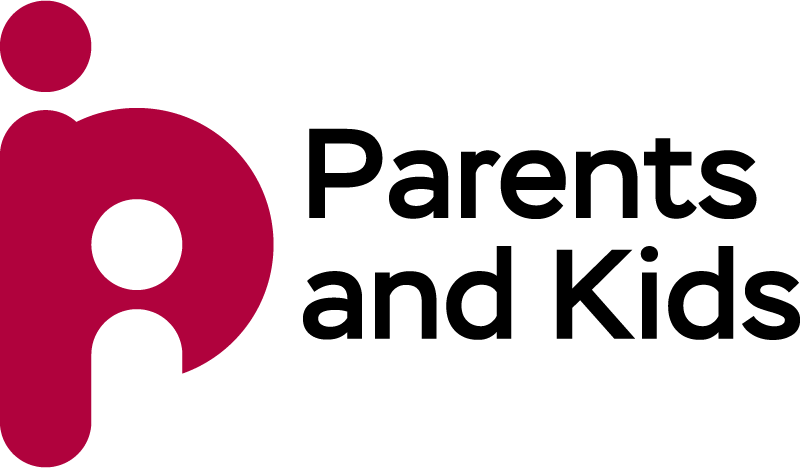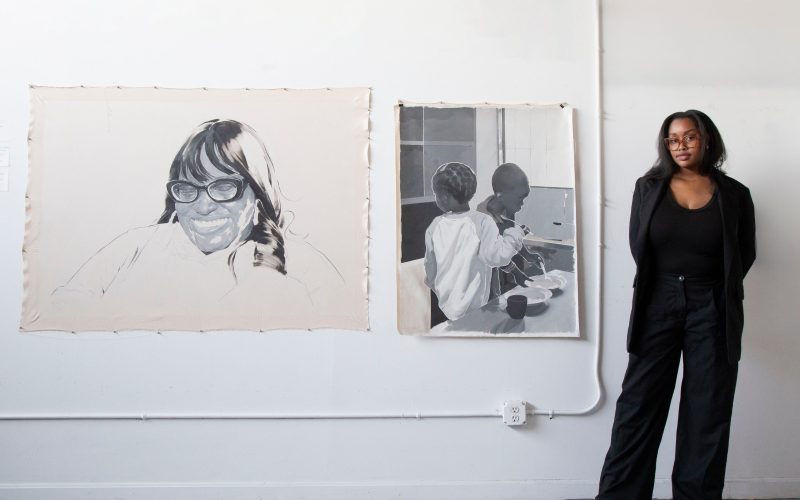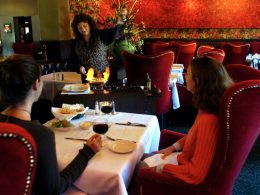The artistFor ten years, Louise Mandumbwas, a painter and printer from Botswana, has been traveling throughout the United States to pursue her art, which addresses the notion of home. Her family has been roaming throughout Africa for generations.
Mandumbwa, 28, is in Ashland this winter term as a visiting artist and scholar in instruction at Southern Oregon University. She has never been this far west in North America; last week, a snowstorm buried roads and shut down schools.
She did, however, return to SOU’s art building on Monday, February 10, across from the Schneider Museum of Art, to demonstrate a printmaking technique that necessitates the image or aluminum matrix being etched in Coca-Cola.
Mandumbwa frequently employs everyday objects in creative ways. She used cement to illustrate the content fading with time on wheat-paste flyers stacked on public walls. Even though she uses oil and charcoal paints, her pictures nonetheless appear ephemeral, as though they are dissolving in front of the viewer’s eyes.
She is fascinated by what fades and what endures.
Her images frequently contain a mystery—a puzzle piece left blank—and have been said to evoke sentiments of warmth, intimacy, and longing. She clarifies that the white space on the left stands for the things she doesn’t know about the character she is playing.
What viewers express about the people they love and are reminded of by my works, as well as what home feels like to them, are always meaningful, Mandumbwa added.
Her family was multilingual, with extended members speaking Portuguese, French, English, and the African vernacular languages of Mbundu, Luvale, Nyanja, and Bemba. She was born in 1996 in Francistown, Botswana.
She came to the United States in 2015 and graduated from Yale University in Connecticut with a Master of Fine Arts in painting and printing after receiving a Bachelor of Fine Arts in painting from the University of Central Arkansas.
She claimed that although a large portion of her work is an excavation of stories she holds dear, these are motivated by underlying concepts of history, home, and collective memory, to which each person has a unique connection.
People sometimes wish to go back to a place that only exists in their memories, she said.
Mandumbwa traveled to a rural community near the border between Zambia and Angola to gather information for her thesis. There, she discovered that the houses made of unfired clay had not survived as her father had remembered, and that many of them had been reincorporated into the ground and replaced by more modern buildings.
The trees her father had climbed forty years prior and the neat plots of land still used to cultivate corn, yucca, and sugarcane were all that remained of the place her father knew.
“Louise is not only a gifted artist but also a kind soul who shares her life story and the story of her family,” said Scott Malbaurn, executive director of the Schneider Museum, who invited Mandumbwa to teach for 11 weeks in Ashland.
Mandumbwa talked about an earlier piece of art that was inspired by a woven plastic laundry bag during an artist lecture on campus on January 23. She explained that the bag was the preferred item for immigrant communities who had to reduce a lifetime’s worth of possessions to what they could carry.
According to her, the cheap, big bags that the African diaspora refers to as “Ghana must go” or “Zimbabwe” are crammed onto buses and the backs of pickup trucks, and they nearly always indicate migration and unrest.
She created a checkered fabric on canvas, and poet Ijeoma Umebinyuo’s words, “And so here you are too foreign for home, too foreign for here, never enough for both,” are printed on the strap.
Mandumbwa reminded the audience during the presentation that although a person’s beginnings play a significant role in who they are, her family has experienced decades of relocation across several nations, leaving them without a physical record of their origins.
According to her, the concept of home was constantly changing.
According to Malbaurn, Mandumbwa’s exploration of her identity via her artwork and human connections produces an artist who is genuinely inspirational and transcends all locations and identities.
“Louise is not bound to one,” he continued, “because she is the daughter and granddaughter of intra-continental immigrants from Zambia, Angola, and the Congo.”
Mandumbwa’s intermediate printmaking class is attended by Lily McGoffin, a junior at Southern Oregon University who is double majoring in psychology and visual art.
The artist, who is helpful in the studio and solves the numerous problems of the printmaking process, is teaching McGoffin a lot, she added.
According to McGoffin, Louise possesses extensive understanding of a variety of printmaking techniques and is highly skilled at elucidating the intricate, sequential procedures involved.
Mandumbwa is able to work in the studio because of her teaching schedule. She views her role at SOU as a chance to connect with Ashland’s artistic community while also assisting her in finding a balance between her artistic endeavors and a longer-term dedication to teaching.
In late March, Mandumbwa will go back to her Connecticut home.
She aims to convey that many feelings and reactions are universal, based on her observations and talks across two continents.
I’ve liked listening to the locals talk about how they know Ashland, and it helps me learn more about it throughout my stay here, she added.
She went on to say, “I’m excited to see how my experiences here will impact my practice in the upcoming months.”
Here is Oregon: Southern Oregon
-
These Oregon festivals and art scenes are nominees for best in the U.S.
-
Pollinator garden brings flowers, color and life to southern Oregon home rebuilt after fire
-
Florists and growers make it easy to buy Northwest flowers for Valentine s Day
-
Fermentopia draws fermented food lovers to southern Oregon
Janet Eastman writes on trends and design. You can follow her on X@janeteastman and contact her at 503-294-4072 and [email protected].










